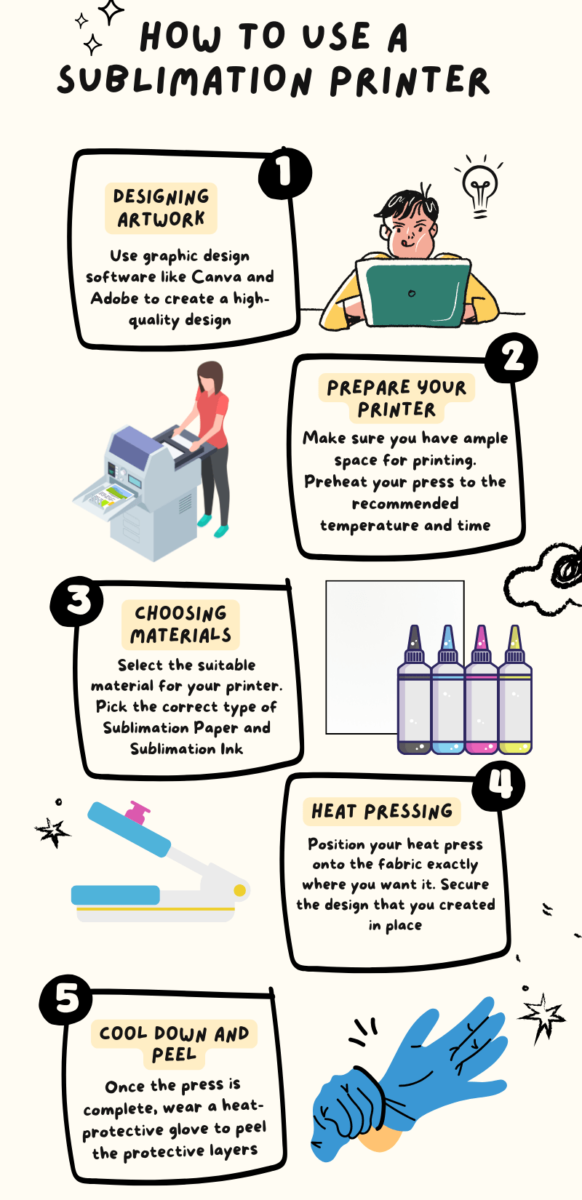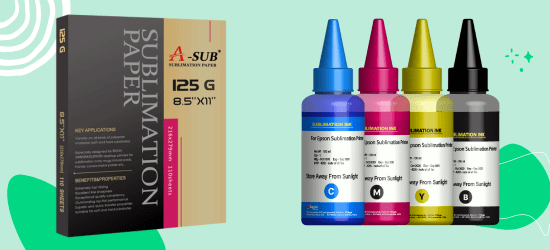We recently did a workshop on Sublimation Printing and the most common question we got was ” Can we use a regular printer? ” We know the answer isn’t straight-forward because its a Yes and a No at the same time. How? Well read ahead to understand it better.
But first, tell us something. Do you want to transform a blank fabric into a vibrant piece of art? If yes, then you will love what a sublimation printing can do!
It simply infuses fabric with ink through heat and pressure and sublimation printers are a popular choice for printing on textiles, metals, ceramics and even glass.
This guide will explore the basics about what is a Sublimation Printer and its types. By the end of it, you will have a full understanding of this printing method. Let’s see what we have in store, shall we?
Do You Know What a Sublimation Printer Is?
Small Business Owners use a sublimation printer to print the ink on a special transfer paper. Then, they position the paper on the surface where they need the design.
From there, the heat transfers the ink on the paper. It sublimates the ink so that the desired material absorbs it. The result? A vibrant, eye-catching, and long-lasting imprint on the material.
But why is it gaining popularity? Unlike traditional printers, this printer offers excellent benefits, such as durable prints and vivid colors. It seamlessly integrates the design with the fabric.
It’s a favorite amongst designers who create a wide range of products, from mugs to t-shirts, photo frames to crockery, and coasters. This is ideal for intricate details, as it makes them stand out!
If you wish to invest in a sublimation printer, keep the following factors in mind:
First look at the printer’s resolution and color accuracy. The higher the resolution, the sharper and more detailed your prints will be. Aim for a printer with at least 300 dpi (dots per inch) for optimal results.
Check the printer’s compatibility with various sublimation inks and papers. Some printers are designed specifically for sublimation, while others may require special cartridges or refillable tanks.
Additionally, consider the printer’s size and speed. If you plan on producing a high volume of sublimated products, a faster printer with a more extensive paper capacity may be a better investment.

Types of Sublimation Printer
There are two significant types of sublimation printers, such as:
Specialized Sublimation Printer
Specialized sublimation printers, such as those offered by Sawgrass and Epson, are designed specifically for the sublimation process. They are equipped with high-quality print heads and are optimized for use with sublimation inks and papers.
They often feature larger paper capacities and faster print speeds, making them ideal for high-volume production. Specialized sublimation printers can be more expensive upfront.
But they offer superior performance and reliability for those serious about creating professional-grade sublimated products.
Inkjet Printers Converted for Sublimation
Conversely, many designers and small business owners opt to convert standard inkjet printers for sublimation use. This involves replacing the printer’s original ink cartridges with specialized sublimation ink cartridges and using sublimation-specific paper.
Popular inkjet printers for conversion include models from Epson and Brother. Converted inkjet printers may not offer the same level of performance as specialized sublimation printers.
But, they can be a more affordable option for those just starting out or with limited budgets. Remember that not all inkjet printers are suitable for conversion, so be sure to research before making a purchase.

Materials Used for a Sublimation Printer
The most common materials used are:
Sublimation Ink
It is a specialized type of ink designed to convert into a gas when exposed to high temperatures. Traditional inkjet inks simply sit on the surface of the paper, while sublimation inks are designed to bond with the fibers of the blank, creating a permanent, high-quality image.
Sublimation Transfer Paper
This specialized paper is coated with a layer of polyester or other polymer designed to hold the sublimation ink in place during the transfer process. When heat and pressure are applied, the ink is released from the paper and bonds with the fibers of the blank.

How to Setup an Inkjet Converted Sublimation Printer
Let’s look at some steps to understand how to setup this printer.
Prepare Your Ink Tanks
When you unbox your printer, you will find a set of inks that needs to go inside those ink tanks. But wait, do not pour them otherwise, you wont be able to convert your regular printer to a Sublimation printer. Instead, order Sublimation Ink and fill your printer’s ink tanks with these inks.
Check the Ink Profile
There are many ICC profiles available on internet and you can find the one for your printer. These profiles help to bring out the most vibrant and pure quality prints from your printer. Additionally, you should also color calibrate your monitor to synchronize it with the ICC profile.
Clean the Print Head and make a Test Print
Before actually printing on a Sublimation Paper, clean the print head once and take out a test print on a regular printer and compare the colors with those on your screen.
How to Maintain a Sublimation Printer
Maintaining your sublimation printer is crucial for ensuring high-quality prints and extending the life of your machine. Regularly cleaning the print heads and nozzles will help prevent clogs and provide smooth, consistent ink flow.
Using high-quality sublimation inks and papers is also essential, as low-quality supplies can damage your printer over time. When not in use, store your printer in a cool, dry place and cover it to protect it from dust and debris.
Following these simple maintenance tips lets you keep your sublimation printer in top condition.
Conclusion
To conclude, a sublimation printer is undoubtedly one of the best devices. You can easily achieve your desired outcome with practice and creativity.
Its vibrant, lasting prints and smooth finish make it ideal for detailed designs. It’s quick to set up, making it perfect for small orders or individual pieces.
Whether you are a merchandiser or just expressing your artistic flair, sublimation printers let you bring your visions to life. Now go on, give it a try, and make a lasting impression!
FAQ
Can I use any ink in a sublimation printer?
No, you can’t use any ink. It requires a special sublimation ink designed to transform from solid to gaseous stage.
Should I consider any safety precautions while using a sublimation printer?
Yes, proper ventilation should be there, as sublimation printing involves the release of gases. Also, the safety guidelines the manufacturers provide for a seamless experience should be followed.

